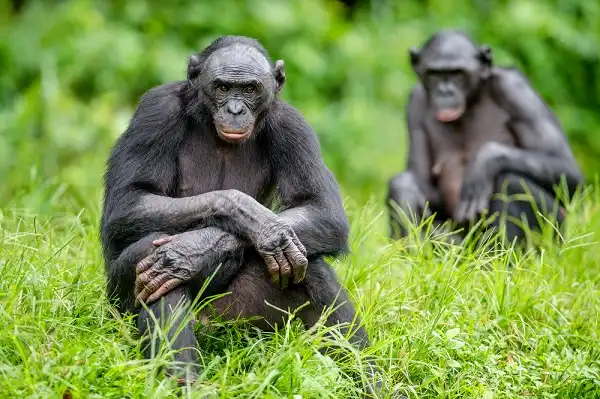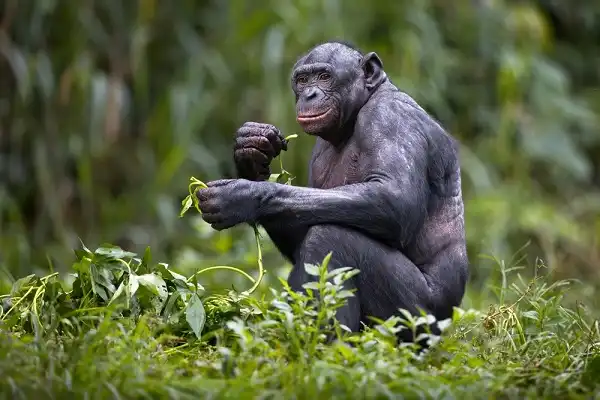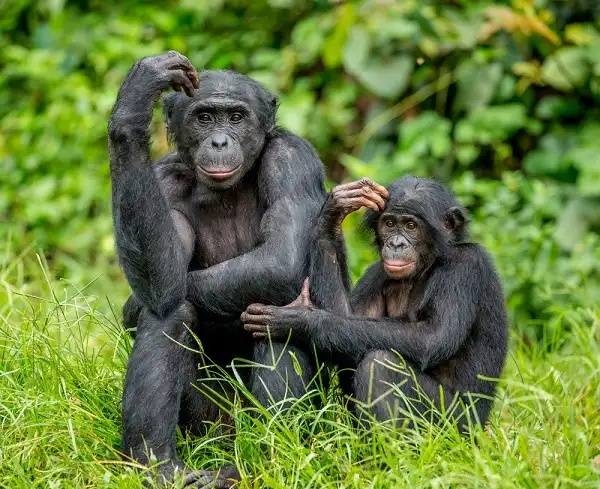Bonobos are an endangered species of great ape native to the Democratic Republic of Congo in Central Africa. Though they look similar to chimpanzees, bonobos have different behavior and anatomy that set them apart. They live in female-dominant societies, where aggression is rare and peaceful resolution is often reached through sexual contact or reconciliation. Bonobos also have longer legs and shorter arms than chimps, plus less pronounced brow ridges over their eyes that give a friendlier expression. With such unique qualities and behaviors, it’s no wonder why these primates deserve our special attention – read on to learn more about bonobo conservation efforts and why we should all care about saving this magnificent species!

Bonobo Description
The bonobo is one of the two species of great apes native to Africa, the other being the chimpanzee. Physically, they resemble chimpanzees but with a few key distinctions. Bonobos have shorter arms and longer legs than chimpanzees, with more upright bodies and heads that are held higher when compared side by side. They also have smoother faces with smaller brow ridges and forward-facing nostrils which give them an overall friendlier expression. Bonobos live in large multi-male/multi-female troops consisting of up to 150 individuals, led by a female dominant hierarchy – females are often reported to be the main decision-makers in their groups. Their societies are highly egalitarian and peaceful; group members rarely display aggressive behavior towards one another, often employing sexual contact and reconciliation as ways to address conflict.
Bonobo Habitat
Bonobos inhabit the rainforests of the Congo Basin in Central Africa. They live primarily in primary and secondary forests, but may also inhabit swampy areas to a lesser degree. Their habitat is characterized by dense vegetation, with thick canopies protecting from the sun and other elements. Despite their classification as a ‘forest-dwelling’ species, bonobos are highly mobile and regularly travel over distances between 1 and 7 km in search of food and new sources of water. Sadly due to habitat loss caused by human activities such as logging, slash-and-burn agriculture, urbanization, and infrastructure development, the bonobo population has been steadily declining since the 1970s. Conservation efforts are essential if we wish to ensure the survival of this endangered ape species; preserving existing habitats is essential for the long-term conservation of bonobo populations in Congo Basin rainforests
Bonobo Diet
Bonobos have a diet rich in fruits, leaves, shoots, bark, insects, eggs, and small mammals. They are highly opportunistic and can eat up to 30 different types of fruit per day when available. To supplement their diet with protein-rich insects, they use tools such as sticks to help them harvest termites. Bonobos also consume items like eggs and small mammals but these are generally eaten less frequently than the other food sources. When it comes to nutrition, bonobos have an advantage when compared to other great apes because they don’t require large amounts of energy to survive; this is due to their slender physique and less active lifestyle. Additionally, their excellent hearing allows them to effectively locate food sources hidden within dense foliage and navigate through their environment with ease.

Bonobo Size
Bonobos range in size from about 65 to 95 cm (2.1 to 3.1 ft) from head to rump and weigh between 25 and 40 kg (55 and 88 lbs). Adult males are slightly larger than adult females, with wider chests and longer arms. Bonobos have long black hair covering their entire body, except for their face, ears, hands, and feet which are all covered in a fine layer of fur. The bonobo is the most slenderly built of the great apes, having a more delicate bone structure than both chimpanzees and gorillas. Its smaller body size is attributed to its diet which consists mainly of fruit, as they require less energy than other great apes due to their more sedentary lifestyle.
Bonobo Lifespan
Bonobos have a surprisingly long lifespan for a primate, with the average life expectancy in captivity ranging from 40 to 60 years. In the wild, however, bonobos are less fortunate; their lifespan is typically much shorter due to disease and predation by other animals. The oldest wild bonobo that was ever recorded was aged 35 years old when it died. Various factors such as diet, climate, health, and social interactions can all affect the lifespan of bonobos. Those living in areas with plentiful food sources and good access to clean drinking water tend to live longer than those living in areas with limited resources. Similarly, healthy individuals with strong immune systems may also be less vulnerable to diseases and able to live longer than those who are not in peak physical condition. Bonobos display similar levels of intelligence as chimpanzees which helps them survive in their environment and find sufficient food sources despite the challenges posed by deforestation, hunting, and urban development. They also possess complex social skills which enable them to form strong bonds within their communities, allowing them to better protect each other from external threats. This combination of traits ensures that bonobos have the best possible chance for a long and healthy life.
Bonobo Behavior
Bonobos are highly intelligent and social animals that live in large, complex communities. They display a variety of behaviors such as tool use, social grooming, communication through facial expressions and body language, and cooperative hunting. Bonobos also exhibit what is known as “prosocial” behavior which involves sharing food and resources, showing concern for injured or ill individuals, participating in conflict mediation, and engaging in cooperative activities such as childcare. Bonobos have been observed to take care of the young of other bonobo families or even unrelated species if they are found alone in distress. In addition to this impressive level of empathy, bonobos often have strong bonds with family members and can even maintain long-term relationships with individuals outside their community. In situations where there is aggression or conflict between members of the group, bonobos typically use nonverbal communication methods such as lip-smacking and loud vocalizations to resolve the issue without violence; this is an example of how the species has developed more peaceful forms of interaction compared to chimpanzees.

Bonobo Speed
Bonobos are remarkable creatures with incredible physical capabilities that enable them to traverse through the dense African rainforest swiftly. Their long limbs give them an advantage when it comes to running, allowing them to reach speeds of up to 30 mph (48 km/h), making them one of the fastest primates in the world. Bonobos have also evolved powerful hind legs that enable them to make huge leaps over obstacles and gaps in the forest floor. This agility helps them escape predators and gives them an edge when searching for food or fleeing from danger. They can cover great distances within a short period by combining their fast running speed with their ability to leap high into the air. In addition, bonobos have great endurance which allows them to maintain these high speeds for long periods if necessary. They can even climb trees faster than any other primate due to their grasping hands and remarkable upper body strength. All these characteristics combine to make bonobos incredibly adept at traveling through their habitat quickly and efficiently.
Bonobo Hunting
Bonobos have been observed to hunt cooperatively, a unique trait among primates. During a hunt, members of the group will work together to locate their prey, often using vocalizations and other nonverbal forms of communication to coordinate their efforts. They use their physical speed and agility to outrun, corner, and capture small mammals such as bush pigs or antelopes. In addition to their ability to hunt in groups, bonobos also possess cognitive skills that allow them to recognize different types of food and plan to gather more efficiently. These skills are further supported by their keen vision which helps them identify potential prey from a distance. Furthermore, they have evolved sharp teeth that enable them to tear through tough hide or even crack open bones for nutrition. Despite the advanced hunting techniques employed by bonobos, they generally prefer fruits when available due to their high nutritional value and abundance in the wild. Still, they are skilled hunters who can quickly adapt their strategies to make the most of whatever resources are present in the environment. Also, when it comes down to it, bonobos display remarkable coordination and problem-solving abilities during hunts which makes them one of nature’s most efficient predators.

Conclusion
Bonobos are one of the most fascinating species on earth. They possess an impressive set of physical and cognitive abilities that enable them to survive and thrive in their African rainforest habitat. Their peaceful behavior, dietary flexibility, speed, cooperative hunting skills, and remarkable intelligence make them truly unique among primates. Bonobos are a testament to the amazing adaptability of nature, and we must protect this incredible species so future generations can continue to appreciate their beauty and complexity for years to come.
Frequently Asked Question


